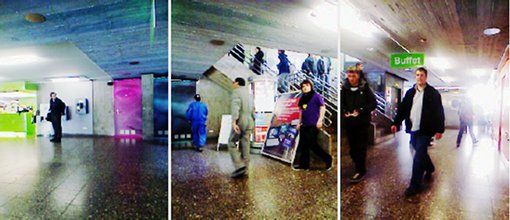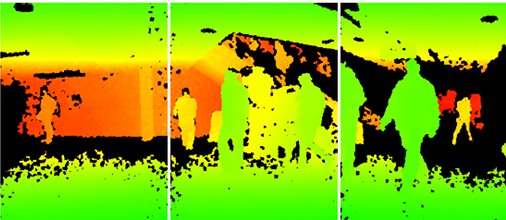Inicio » dataset
Archivos de la categoría: dataset
Dataset: Background Models Challenge 2012
- The dataset is divided into:
- Set of videos for learning purposes with ground truth.
- Set of synthetic videos for evaluation purposes with encrypted ground truth.
- Set of real videos for evaluation purposes with encrypted ground truth.
- Software (not source code) to automatically test the background subtraction results (making use of the encrypted ground truth).
SENSIAC: dataset for Automatic Target Recognition in infrared imagery
From the website of SENSIAC:
The ATR (Automated Target Recognition) Algorithm Development Image Database package contains a large collection of visible and MWIR (mid-wave infrared) imagery collected by the US Army Night Vision and Electronic Sensors Directorate (NVESD) intended to support the ATR algorithm development community. This database provides a broad set of infrared and visible imagery along with ground truth data for ATR algorithm development and training.
Included in the database: 207 GB of MWIR imagery, 106 GB of visible imagery, a seven-section user’s guide, an image viewer, ground truth data, meteorological data, photographs of targets, and other documentation to assist the user in correctly interpreting the imagery. Targets include people, foreign military vehicles, and civilian vehicles at a variety of ranges and aspect angles. All imagery was taken using commercial cameras operating in the MWIR and visible bands. Calculated target temperature differentials relative to the background are provided as well.

Prices:
Government,
Academia,
Members$250 Others $350 Foreign $400
LIRIS human activities dataset with depth data
This dataset had been originally shot for the ICPR 2012 human activities recognition and localization challenge (ICPR HARL). Target applications are the recognition of complex human activities, focusing on complex human behavior involving several people in the video at the same time, on actions involving several
interacting people and on human-object interactions.The dataset has been shot with two different cameras:
- a moving camera mounted on a mobile robot delivering grayscale videos in VGA resolution and depth images from a consumer depth camera (Primesense/MS Kinect); – a consumer camcorder delivering color videos in DVD resolution.
- The dataset comes with full annotation and several tools and consistsof the following parts:
- Video data (rgb, grayscale and depth frames).
- XML annotations of the activity bounding boxes.
- Calibration data and software for the MS Kinect depth sensor used during acquisition.
- Software for browsing videos and annotations (superimposed rectangles) and also for the creation of new annotations
- Software for evaluating new recognition software : automatic creation of precision/recall curves and integration of localization information into the evaluation process.
The dataset is centered on the following action classes:
- Discussion of two or several people.
- A person gives an item to a second person.
- An item is picked up or put down.
- A person enters or leaves an room.
- A person tries to enter a room unsuccessfully.
- A person unlocks a room and then enters it.
- A person leaves baggage unattended (drop and leave).
- Handshaking of two people.
- A person types on a keyboard.
- A person talks on a telephone.
Traffic Sign Recognition datasets
- German Traffic Sign Recognition Benchmark: a large multi-category classification benchmark.










Kinect datasets
-
List
- RGB-D Person Re-identification Dataset [Link]
- Oriented to person re-identification using depth information.
- Matlab script for interfacing the dataset.
- RGB-D People Dataset. [Link]
- Ground truth.
- Suitable for video tracking.
- Contain RGB and depth images acquired from different Kinect sensors simultaneously.
- NYU Depth Dataset. [Link]
- Ground truth.
- Segmentation oriented.
- Matlab code for interfacing it.
- RGB-D Object Dataset. [Link]
- Segmentation oriented.
- Biwi Kinect Head Pose Database. [Link]
- Ground truth.
- Head pose.
- IROS 2011 Paper Kinect Dataset. [Link]
- Ground truth.
- Camera calibration, scene reconstruction.
- RGB-D SLAM Dataset and Benchmark. [Link]
- Ground truth.
- Visual odometry and visual SLAM.
- Kinect (RGB+D) dataset by the CVPR team at Technische Universitat Munchen. [Link]
- Ground truth.
- Visual odometry and visual SLAM.
Visual samples

RGB-D Person Re-identification Dataset 
RGB-D People Dataset -

RGB-D People Dataset
Resources about motion segmentation
Code
- Robust Motion Segmentation via Lossy Compression by Shankar Rao. [Link]
- Matlab code.
- Motion segmentation algorithms by Visionlab. [Link]
- GPCA with spectral clustering.
- RANSAC (RANdom SAmple Consensus).
- Local Subspace Affinity (LSA).
- Matlab code.
- Motion Segmentation algorithms by Luca Zappella [Link]
- Joint Estimation of Segmentation and Structure from Motion (JESS).
- Adaptive Subspace Affinity (ASA, aka PAC and SCbA).
- Enhanced Local Subspace Affinity (ELSA).
- Enhanced Model Selection (EMS).
- Matlab code.
- Motion Segmentation using Linear Combination of Views by Vasileios Zografos. [Link]
- It requires two views.
- Matlab code.
Datasets
-
Hopkins 155 dataset by Visionlab. [Link]
